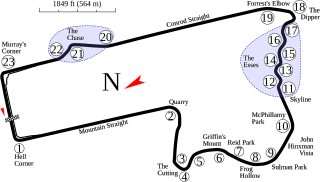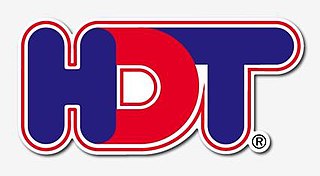
The Holden Torana is a mid-sized car that was manufactured by Holden from 1967 to 1980. The name apparently comes from a word meaning "to fly" in an unconfirmed Aboriginal Australian language. The original HB series Torana was released in 1967 and was a four-cylinder compact vehicle closely based on the British Vauxhall Viva HB series of 1966–1970.

The Bathurst 1000 is a 1,000-kilometre (621.4 mi) touring car race held annually on the Mount Panorama Circuit in Bathurst, New South Wales, Australia. It is currently run as part of the Supercars Championship, the most recent incarnation of the Australian Touring Car Championship. In 1987 it was a round of the World Touring Car Championship. The Bathurst 1000 is colloquially known as The Great Race among motorsport fans and media. The race originated with the 1960 Armstrong 500 with a 500 mile race distance at the Phillip Island Grand Prix Circuit; it was relocated to Bathurst in 1963 also with the 500 mile distance and has continued there every year since extending to a 1,000 kilometer race in 1973. The race was traditionally run on the New South Wales Labour-Day long weekend in early October. Since 2001, the race has been run on the weekend following the long weekend, generally the second weekend of October.

The Holden Dealer Team (HDT) was Holden's semi-official racing team from 1969 until 1986, primarily contesting Australian Touring Car events but also rallying, rallycross and Sports Sedan races during the 1970s. From 1980 the Holden Dealer Team, by then under the ownership of Peter Brock, diversified into producing modified road-going Commodores and other Holden cars for selected dealers via HDT Special Vehicles.
Allan George MoffatOBE is a Canadian-born Australian racing driver known for his four championships in the Australian Touring Car Championship, six wins in the Sandown 500 and his four wins in the Bathurst 500/1000. Moffat was inducted into the V8 Supercars Hall of Fame in 1999.

The Holden Commodore (VB) is a mid-size car that was produced by Holden, from 1978 to 1980. It was the first iteration of the first generation of the Holden Commodore.

The Holden Commodore (VC) is a mid-size car that was produced by Holden, from 1980 to 1981. It was the second iteration of the first generation of the Holden Commodore.

The Holden Commodore (VN) is a full-size car that was produced by Holden from 1988 to 1991. It was the first iteration of the second generation of this Australian made model, which was previously a mid-size car, as well as the first Commodore available as a coupé utility. The new range included the luxury variants, Holden Berlina (VN) and Holden Calais (VN) and, from 1990, introduced the commercial Holden Utility (VG).

The Holden Commodore (VL) is a mid-size car that was produced by Holden from 1986 to 1988. It was the final iteration of the first generation of the Holden Commodore and included the luxury variant, Holden Calais (VL). Between February 1986 and August 1988, 151,801 VL model Commodores were built.

The Holden Commodore (VK) is a mid-size car that was produced by Holden from 1984 to 1986. It was the fourth iteration of the first generation of the Holden Commodore and introduced the luxury variant, Holden Calais (VK) sedan.

Allan Maxwell Grice, known to motor-racing fans as "Gricey", is an Australian former racing driver and politician, most famous for twice winning the prestigious Bathurst 1000, and as a privateer driver of a Holden in the Australian Touring Car Championship.
The 1987 Australian Touring Car Championship was a motor racing competition which was open to Touring Cars complying with regulations as defined by the Confederation of Australian Motor Sport and based on FIA Group A rules. The championship, which was the 28th Australian Touring Car Championship, began on 1 March 1987 at Calder Park Raceway and ended on 5 July at Oran Park Raceway after nine rounds. The Calder round saw the world debut of the racing versions of the BMW M3, the Ford Sierra RS Cosworth and the Alfa Romeo 75 Turbo.
Robert Morris is an Australian former racing driver. Morris was one of the leading touring car drivers during the 1970s and continued racing until 1984. Morris won Australia's premier Touring car race, the Bathurst 1000 in 1976. He also won the Australian Touring Car Championship in 1979. Morris was inducted into the V8 Supercars Hall of Fame in 2004.

The 1982 James Hardie 1000 was the 23rd running of the Bathurst 1000 touring car race. It was held on 3 October 1982 at the Mount Panorama Circuit just outside Bathurst in New South Wales, Australia. The race, which was Round 3 of both the 1982 Australian Endurance Championship and the 1982 Australian Endurance Championship of Makes, was open to cars eligible to the locally developed CAMS Group C touring car regulations with two engine capacity based classes.
John Francis Harvey was an Australian racing driver. He was a top Speedcar driver for many years in the 1950s and 1960s, winning many championship races including the NSW Championship for three successive years and the Victorian Championship twice before turning his skills to road racing where he had a long and successful career until his retirement at the end of 1988. In 1987 John made history driving the General Motors Sunraycer to victory in the inaugural World Solar Challenge from Darwin to Adelaide, the first international race for purely solar powered cars.
David John "Skippy" Parsons, is a retired Australian racing driver, who, while never a full-time racing driver, drove for some of the leading racing teams in Australia including the Holden Dealer Team, Perkins Engineering, Glenn Seton Racing and Gibson Motorsport.
Graeme Alfred Bailey, is an Australian retired racing driver, best known as co-winner of the 1986 Bathurst 1000.
The 1984 Australian Touring Car Championship was a motor racing competition for Group C Touring Cars. The Championship was authorised by the Confederation of Australian Motor Sport as an Australian National Title. It was the 25th Australian Touring Car Championship, and the last to be contested by Group C cars as new regulations, based on international Group A, were introduced for 1985.
The 1982 Australian Touring Car Championship was a CAMS sanctioned Australian motor racing title open to Group C Touring Cars. It began on 18 February 1982 at Sandown Raceway and ended on 16 May at Oran Park Raceway after eight rounds. The title, which was the 23rd Australian Touring Car Championship, was won by defending champion Dick Johnson, driving a Ford XD Falcon.

The 1983 Australian Touring Car Championship was a CAMS sanctioned motor racing title for drivers of Group C Touring Cars. The title, which was the 24th Australian Touring Car Championship, was contested over a series which began on 6 February 1983 at Calder Park Raceway and ended on 19 June at Lakeside International Raceway after eight rounds.
AMSCAR was a touring car series held in Australia between 1979 and 1997, based at Amaroo Park in Sydney.

















